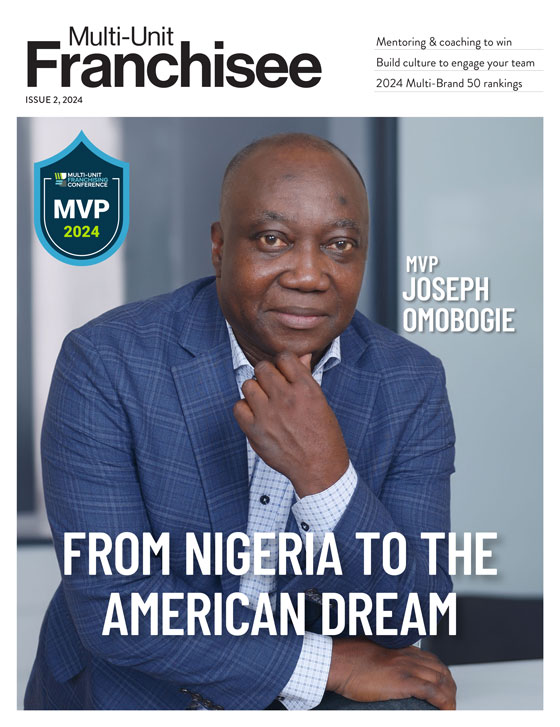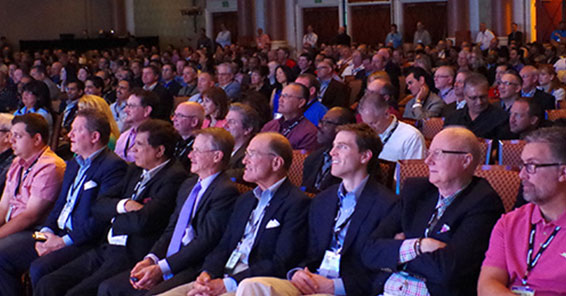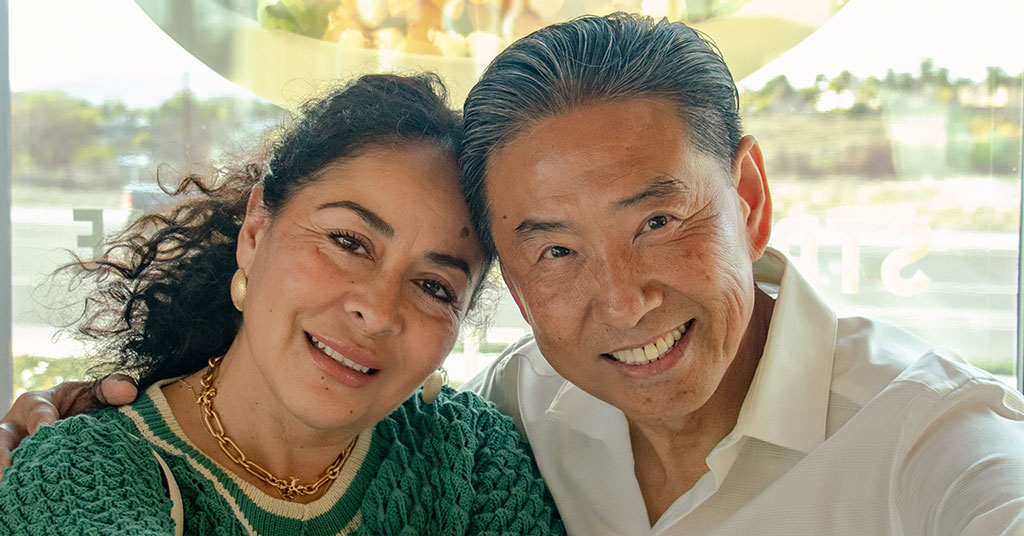Engaging the Team: Successful franchisees build winning cultures

A franchisee can’t serve each customer. From day to day, they need teams of people to help them accomplish everything that must be done to build a successful business. That’s why it’s important to establish a winning culture that engages employees and incentivizes them to provide stellar customer service.
In the aftermath of the pandemic and the Great Resignation, low unemployment rates mean workers have options. Business leaders have long understood that customers choose where to spend their dollars. They’re also adapting to the reality that workers have choices about where to sell their time.
Organizations of all sizes are developing ways to acknowledge their teams’ contributions. Strategies include awarding points and prizes for standout performance, focusing on hiring from within, and making sure a worker’s tires are safe enough to get them between home and work each day.
However, culture goes beyond strategies. When done right, it’s a fundamental part of growing a business. Read on to see how leaders can turn employees into team members.
People first
CEO Jim Balis and other leaders at Sizzling Platter, which operates nearly 750 restaurants, spent 2022 changing the company’s mission statement to reflect its priorities: “We provide unparalleled experiences for our team members, guests, and brands while driving strong financial performance to become the world’s premier franchise platform.”
The mission statement appears on the first page of the company’s website. Click on the “Who We Are” button, and the words “We are a people first company” pop up. Scan down the page a little further, and Sizzling Platter advertises that in 2022, the company promoted more than 5,000 people and gave raises to more than 6,500 employees.
“It’s very important to be an employer of choice and to really take care of our people and engage with our team members on a personal level,” Balis says.
Sizzling Platter’s expansive portfolio includes Little Caesars, Jamba, Wingstop, Dunkin’, Jersey Mike’s Subs, Cinnabon, Red Robin Gourmet Burgers, and Sizzler. Balis can’t have a personal conversation with each of his thousands of employees. However, he and his leadership team consistently communicate how important team members are to everything the company wants to accomplish. By creating and reinforcing a culture of appreciation, Sizzling Platter sends a message to everyone in the organization.
“Even when we have meetings on the financial performance of our business, our brand presidents start off with an example of how we’ve lived up to our mission statement the last week. There are some incredible stories that come out of that,” Balis says. “This isn’t just about driving financial performance. We also want to really stress and highlight the importance of our culture and how we’re focusing efforts there.”
The dynamic between employers and employees has changed in the wake of the pandemic. The Sizzling Platter team recognized the need to engage with team members and take care of them. The approach starts on day one. “We put a lot of effort now into that first day, making sure they have uniforms, making sure we prepared for them, and making sure they get the training they need,” Balis says.
Follow-up surveys ask about the team member’s first day, first week, and first month. Other questions cover how training can be improved and how the new hire is fitting in with the team. “We want them to feel comfortable at their job,” Balis says, “and we don’t want them stressed because we’re not properly staffed.”
Photos of new hires appear on a screen in the back of the house as a way to welcome them. Whenever someone gets a positive review from a customer, that shows up on the screen as well. Sizzling Platter also uses a third-party provider to award points that can be exchanged for prizes. “We really try to use it for reaffirming how much we appreciate everything they’re doing day in and day out,” Balis says.
Managers who exemplify Sizzling Platter’s culture receive financial rewards and attend a yearly retreat in Mexico. Financial performance matters and so does having a history of promoting from within. Balis says that when employees see how the company cares for them, they’re more likely to provide high-quality service to customers.
“We can’t stay static, right?” Balis says. “We’re constantly looking at ways to be better and to evolve in positive ways.”
For more about Jim Balis, read Page 10
Changing approaches
Greg Goodman, a co-creator of Turbo Tint and a franchisee, considers his employees to be as important as the customers who visit his two locations in Oklahoma City. However, he didn’t start out believing in an employee-first culture.
“I was just an employer hiring employees and expecting them to do their job from 8 a.m. to 5 p.m.,” says Goodman, CEO of DBA Turbo Tint. “I wasn’t really invested in my employees.”
Over time, he noticed a problem with that approach. The people he’d spent so much time training kept leaving for other jobs. The bottom-line issue caught his attention, but he didn’t solve his problem until he recognized the human issue.
“I tried to put myself in their position. What would I like to see this company do for me?” he says. “That’s when I started making sure my guys had health insurance. It’s very important that my guys are healthy and can afford to go to the doctor.”
That was just the beginning. Team members now get their birthdays off from work with pay. Leeway is built into the schedule for parents to catch an important ball game or band performance. Once a quarter, the business shuts down, and employees go bowling, golfing, or some other outing to build teamwork. In addition, the team gets a free lunch each week, and workers select the menu. Lunch happens each Thursday, and it’s followed by “Whiskey Friday,” when the business shuts down for the week at 4 p.m. instead of 5 p.m.
“They could have a glass of whiskey if they wanted. They could have a beer if they wanted,” Goodman says. “We would talk about women. We talked about cars. We talked about politics. We talked about whatever. But there’s no talking about work. It’s about camaraderie.”
In addition to building their team and serving customers, Goodman and his son Chandler represent the brand and teach the Turbo Tint way to new franchisees and installers who visit Oklahoma City.
“We really push the team culture, and we just try to get new owners to emulate what we do,” says Chandler Goodman, COO of DBA Turbo Tint.
In recent years, Goodman has pulled away from day-to-day operations, and his son has stepped in. Chandler Goodman manages the two locations and is committed to maintaining the same culture-building policies that his father started.
“We think of them as part of our team rather than employees,” Chandler Goodman says. “Our whole production system is based on a team. They work together to complete the vehicle or the job as quickly as possible.”
There must be accountability, but there’s also a general understanding that people will mess up at times. “We tell our customers that even Rolls Royce has a service department, so no matter how good you are, there will be mistakes,” Chandler Goodman says. “I don’t care if it was our top dog or the guy who just started tinting yesterday. It does not matter to me. Fix it and move on.”
He can’t provide an ROI on investing in people, but he sees no bottom-line or human reason to veer from the path his dad set years ago. “I will tell you, our guys fully buy into it,” he says.
Calm and collected
For a positive culture to take hold, people up and down the organization need to buy in. If procedures aren’t promoted and modeled by the person at the top, the team won’t adopt them.
“It’s just a daily thing,” says Mark Boyd, who owns House Doctors and 360 Painting territories in Augusta, Georgia, and Aiken, South Carolina. “You have to get up every day prepared to process your own emotions and to process the emotions of others. That’s what it takes to be successful.”
In his experience, home repair can stir up emotions for customers, employees, and subcontractors. Mistakes and misunderstandings happen, and tempers can get heated. Boyd says his first job is to project calm when dealing with conflicts.
“The biggest thing is don’t panic so you can keep the team in line,” he says. “Team members are afraid they’ve let the customer down, or they’re afraid that they’re going to be blamed, or they’re afraid that they’re going to let their employer down, which creates a fear that they’re going to lose their job.”
In those situations, the goal is to alleviate that fear, so the worker doesn’t act on it and worsen the situation. Problems at the job site aren’t always caused by the job. There might be underlying factors at play.
“Groceries are expensive, fuel is expensive, cars are expensive, and just to rent a home is very expensive now,” he says. “A lot of times, it’s just solving that daily life need now and seeing if you can help them so that they can be productive. Do they need tires on the car to make it safe for their family?”
Boyd says his approach has affected profitability because he’s not constantly training new workers. It’s also helped attract workers because team members and subcontractors tell others about the culture. “When people are trained, they understand what your guidelines and what your rules are,” he says. “Then they can teach it to the next person we hire.”
It helps that he’s an owner-operator, so he spends plenty of time with his frontline employees and gets to know them. However, maintaining and modeling culture isn’t easy. It took him years to arrive at his approach as he learned from watching good and bad managers. He also studies management and leadership books by Steven Covey, John Maxwell, and others.
“You have to be prepared to take a moment to really understand what that person is going through and see if we can work through it,” he says.
Opportunities abound
Working nights in an intensive care unit in St. Louis doesn’t provide Dr. Eric Jenkins much time to oversee his frontline workers at seven MassageLuXe locations in Florida and one in Pennsylvania. He relies on his regional manager and general managers to shape the culture at his studios.
“It works out really well because I have an amazing regional manager and good general managers at each location, so I’m able to have my proxies in place who do exactly what I would hope that I was doing,” Jenkins says. “Obviously, when you get to a multi-franchisee level, you can’t clone yourself. If you don’t have people in place that represent you, you’re never going to be able to do it anyway.”
He’s learned that there’s a vast difference between having a person in place and having the right person for the job. When getting the Pennsylvania studio online, he had a different regional manager who might have said the right things but didn’t always follow through.
“It has to be consistent,” he says. “If it waxes and wanes, it’s not culture.”
After firing that manager, he elevated an employee who had started as a receptionist when she was in high school and earned a degree in hospitality management. She’d moved up from shift supervisor to general manager. “I put her in place, and she really ran with the position,” he says. “Now, we almost never hire managers from outside.”
When hiring new front desk workers, it’s understood that some will be transient, but Jenkins says it’s important for his staff members to see that they can move up in the company and build their careers.
“We try to keep a two or three-deep leadership in mind so that we have a general manager who’s supported by a good assistant manager,” Jenkins says, “and then they have shift supervisors who are ready to step in when somebody may get sick, or we may need somebody to step up if somebody moves on. It’s so much more successful that way because they see the culture.”
In addition to putting the right people in place, Jenkins sets goals that embody the culture he wants to cultivate. Profitability is important, but he says it’s also crucial that his staff members don’t feel as though their jobs are constantly on the line.
“I’m not a person who’s just going to fire somebody because they had one bad month,” he says. “Let’s find out what they need. Maybe they’ve had to take an Uber to work every day because their car is in the shop. I put too much into these people to just discard them when they’re having a bad month.”
Jenkins says the MassageLuXe corporate team provides training to help build the right culture at his locations. He’s also learned from Boy Scout and church leaders who trusted him with responsibility when he was growing up.
“You’re saying, ‘Here’s your responsibility. I’m going to teach you what you need to do, and then you do it,’” Jenkins says. “I like that model.”
The value of time
Chris McJunkins started busing tables at age 15, and he’s been a bartender, host, waiter, dishwasher, and cook over the years. During that time, the contrast between good bosses and bad ones helped him develop his approach to management.
“I was just a young floor manager and had a great boss who taught me. He would take the time to teach you a lot and treat everybody fair,” McJunkins says. “Then you have a different boss, and it’s like, ‘Wait a minute. This is the same restaurant or same concept, but the leader is different.’”
As CEO of McJunkins Restaurant Group, he’s in charge of 10 Walk-On’s Sports Bistreaux locations and two Smalls Sliders locations (with a third on the way) in Louisiana, Arkansas, and Texas. He says leaders must set the tone and establish culture.
“If you’re in the restaurants day to day, every single day in the same building, you can create the culture,” he says. “You’re there. You’ve got your hands on it. You’re touching everybody. You’re touching every customer and touching every employee. As we have grown, obviously, I can’t be in every store every day.”
McJunkins relies on like-minded people to run his restaurants and treat employees the way they should be treated. It’s his job to teach his managers and motivate them to run their locations properly. In a way, he’s passing down lessons he’s learned from Brandon Landry, the founder of Smalls Sliders and Walk-On’s.
“He’s a master. You can feel that he cares,” McJunkins says. “Everybody might want his attention, but when he’s talking to you, you’ve got his attention. He’s able to share his vision, and everybody wants to make it that way. Culture starts at the top.”
If McJunkins’ managers boost sales at their restaurant, they earn a share of profits. Rather than looking for opportunities elsewhere, they stay where their efforts are rewarded and continue to apply their skills and experience. “If you can keep the consistency going, you keep staff,” McJunkins says.
In a tight labor market, it’s important for workers to feel valued. McJunkins and his team achieve this by showing a healthy respect for staff members’ time. “Let’s just say you have eight servers on a shift and you schedule 12,” he says. “Four of them could have been home doing whatever they wanted to do. And the other eight could have been making the money that they should have been making instead of spreading it out to 12 servers.”
The same approach to scheduling applies to busboys, cook staff, and everyone else. “If they’re going to come to work, we’re going to make sure it’s worth their time,” McJunkins says.
Training and motivation are always important and necessary, but McJunkins says there is a limit to what they can do. In some cases, the best way to maintain a good culture is to let someone go.
“Sometimes, you just know that you made a bad hire. They don’t fit into your culture, but you’ll hold on to that person, thinking you can change them,” he says. “Sometimes, you do all you can to train or motivate or engage in private one-on-one conversations to get them on the same page as the rest of the group. At some point, you know it’s not going to work out.”
Customers have a choice of where to spend their money. Success often comes down to the quality of service frontline staff members provide, and those employees also have choices to make.
“I know it’s an old cliche, but it’s true,” McJunkins says. “Do you treat people like you want to be treated?”
What is culture?
An organization’s culture reflects its shared attitudes, values, goals, and practices. It’s not an add-on, but a foundational touchstone that binds teams together and makes great things possible. As Larry Senn, the author of Winning Teams, Winning Cultures, says, “Culture is not an initiative. Culture is the enabler of all initiatives.”
Here are some other takes on culture:
• “A hallmark of a healthy creative culture is that its people feel free to share ideas, opinions, and criticisms. Lack of candor, if unchecked, ultimately leads to dysfunctional environments.”—Ed Catmull, author of Creativity, Inc.: Overcoming the Unseen Forces That Stand in the Way of True Inspiration.
• “Listen, involve, synergize at work. Then you will bury the old and create an entirely new winning culture which will unleash people’s talents and create complementary teams where strengths are made productive and weakness are made irrelevant through the strengths of others.”—Stephen Covey, author of The Seven Habits of Highly Successful People.
• “Corporate culture matters. How management chooses to treat its people impacts everything for better or for worse.”—Simon Sinek, author of Start with Why: How Great Leaders Inspire Everyone to Take Action.
• “Company culture is the backbone of any successful organization.”—Gary Vaynerchuk, author of Twelve and a Half: Leveraging the Emotional Ingredients Necessary for Business Success.
• “Employee engagement arises out of culture and not the other way around.”—Moe Carrick and Cammie Dunaway, co-authors of Fit Matters: How to Love Your Job.
• “Culture does not change because we desire to change it. Culture changes when the organization is transformed—the culture reflects the realities of people working together every day.”—Frances Hesselbein, author of My Life in Leadership: The Journey and Lessons Learned Along the Way.
• “No company, small or large, can win over the long run without energized employees who believe in the mission and understand how to achieve it.”—Jack Welch, author of Winning.
• “To win in the marketplace, you must first win in the workplace.”—Douglas Conant, author of TouchPoints: Creating Powerful Leadership Connections in the Smallest Moments.
• “Good leadership requires you to surround yourself with people of diverse perspectives who can disagree with you without fear of retaliation.”— Doris Kearns Goodwin, author of Team of Rivals: The Political Genius of Abraham Lincoln.
Share this Feature
Recommended Reading:
| ADVERTISE | SPONSORED CONTENT |
FRANCHISE TOPICS
- Multi-Unit Franchising
- Get Started in Franchising
- Franchise Growth
- Franchise Operations
- Open New Units
- Franchise Leadership
- Franchise Marketing
- Technology
- Franchise Law
- Franchise Awards
- Franchise Rankings
- Franchise Trends
- Franchise Development
- Featured Franchise Stories
FEATURED IN

Multi-Unit Franchisee Magazine: Issue 2, 2024
| ADVERTISE | SPONSORED CONTENT |

$100,000





 The multi-unit franchise opportunities listed above are not related to or endorsed by Multi-Unit Franchisee or Franchise Update Media Group. We are not engaged in, supporting, or endorsing any specific franchise, business opportunity, company or individual. No statement in this site is to be construed as a recommendation. We encourage prospective franchise buyers to perform extensive due diligence when considering a franchise opportunity.
The multi-unit franchise opportunities listed above are not related to or endorsed by Multi-Unit Franchisee or Franchise Update Media Group. We are not engaged in, supporting, or endorsing any specific franchise, business opportunity, company or individual. No statement in this site is to be construed as a recommendation. We encourage prospective franchise buyers to perform extensive due diligence when considering a franchise opportunity.